
Campanula is one of several genera of flowering plants in the family Campanulaceae commonly known as bellflowers. They take both their common and scientific names from the bell-shaped flowers — campanula is Latin for "little bell".

Campanula americana, the American bellflower, or tall bellflower, is a bellflower native to eastern North America. Tall bellflowers can be annual or biennial with a varying life-history with seeds germinating in the fall producing annual plants and spring-germinating seeds producing biennial plants. Long-tongued bees are the primary pollinators, including Megachile campanulae, but halictid bees, butterflies, and skippers may also act as pollinators. Tall Bellflowers do not generally self-pollinate. Some authorities, including the USDA PLANTS database, consider the name Campanulastrum americanum to be the accepted name for this species.

Campanula exigua, the chaparral bellflower, rock harebell, or Rattan campanula, is an annual flowering plant in the bellflower family Campanulaceae.
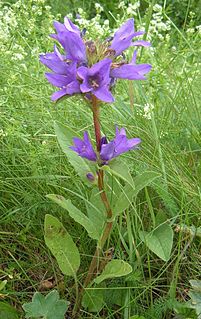
Campanula glomerata, known by the common names clustered bellflower or Dane's blood, is a species of flowering plant in the genus Campanula, belonging to the family Campanulaceae. It is the county flower of Rutland, England.

Campanula pyramidalis, the chimney bellflower, is a species of Campanula, native to southeastern Europe in Italy and the western Balkans. Campanula means "bell-like" referring to the bell-shape of its flowers, while pyramidalis means pyramidal or conical, which refers to its conical shape.
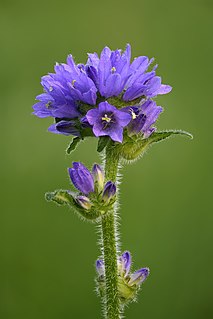
Campanula cervicaria, the bristly bellflower, is a species of flowering plant in the bellflower family Campanulaceae. The plant is roughly hairy and the flowers are about 1–2 centimetres (0.4–0.8 in) long, light blue and are grouped together.

Campanula latifolia, the giant bellflower, is a species of bellflower in the family Campanulaceae. It is also known as the large campanula and the wide-leaved bellflower. It is native to Europe and western Asia and is widely grown as an ornamental plant.

Campanula trachelium, the nettle-leaved bellflower, is a species of bellflower. It is a Eurasian blue wildflower native to Denmark and England and now naturalized in southeast Ireland. It is also found southward through much of Europe into Africa.
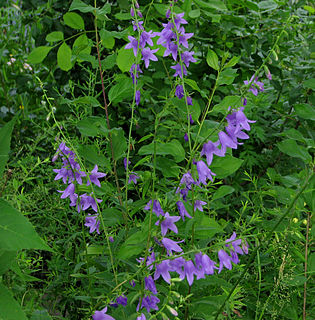
Campanula rapunculoides, known by the common names creeping bellflower, or rampion bellflower, is a perennial herbaceous plant of the genus Campanula, belonging to the family Campanulaceae. In some parts of North America, it is an extremely invasive species.
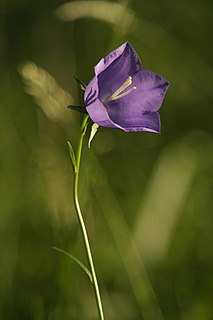
Campanula persicifolia, the peach-leaved bellflower, is a flowering plant species in the family Campanulaceae. It is an herbaceous perennial growing to 1 m. Its flowers are cup-shaped and can be either lilac-blue or white. Its foliage is narrow and glossy with a bright green appearance.
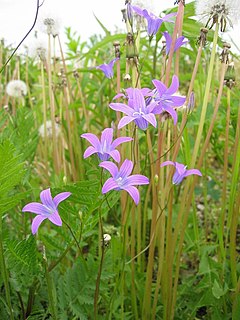
Campanula patula or spreading bellflower is a plant species of the genus Campanula. It can grow to more than half a meter high. This delicate bellflower bears lateral branches of pale blue or white flowers that are upright and funnel shaped. The leaves are narrow and pointed. Branches are often supported by the surrounding vegetation, so the plants can appear prostrate. The main difference between this and other bellflowers is that the petals in the bell are spread out and more pointed and this gives this species its common name.

Campanula scouleri is a species of bellflower known by the common names pale bellflower and Scouler's harebell. It is native to the mountains of western North America from northern California to Alaska. It is a rhizomatous perennial herb producing an erect or leaning stem 20 to 30 centimeters long. The leaves are thin to leathery, lance-shaped to round, and generally toothed, measuring 1 to 6 centimeters long and borne on short winged petioles. The pale blue bell-shaped flower has a strongly reflexed corolla with lobes curling back and sometimes almost touching. The style protrudes far from the center of the flower; it is blue in color and up to 1.5 centimeters long.

Campanula poscharskyana, the Serbian bellflower or trailing bellflower, is a semi-evergreen trailing perennial, valued for its lavender-blue star-shaped flowers. It is native to the Dinaric Alps in former Yugoslavia.

Campanula portenschlagiana, the wall bellflower, is a species of flowering plant in the family Campanulaceae, native to the Dalmatian Mountains in Croatia. It is a vigorous, low-growing, mound-forming evergreen perennial with deep purple flowers in summer. Other common names include Dalmatian bellflower, Adria bellflower and Campanula muralis.
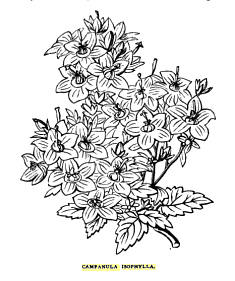
Campanula isophylla is a species of plant. The common names of the species include Italian bellflower, star of Bethlehem, falling stars and trailing campanula.

Favratia zoysii, known commonly as Zois' bellflower, Zoysi's harebell, or crimped bellflower, is the sole member of the genus Favratia, closely related to Campanula (bellflowers).

Campanula piperi is a species of flowering plant in the bellflower family, Campanulaceae. It is native to the Olympic Mountains on the Olympic Peninsula in the U.S. state of Washington. It has also been noted on Vancouver Island, British Columbia.

Campanula scheuchzeri is a species of bellflower in the family Campanulaceae. The Latin name of the species honors the Swiss botanist Johann Jakob Scheuchzer.
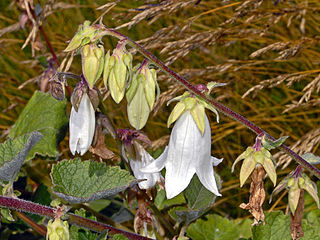
Campanula lanata, the woolly bellflower, is a biennial herb belonging to the family Campanulaceae.





















